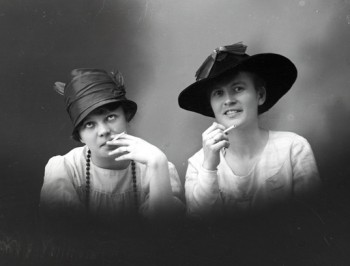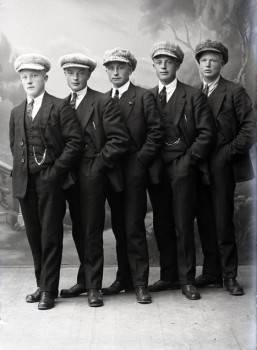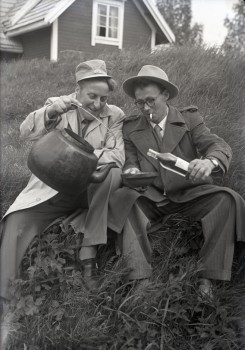Life through the lens
22 December 2010 | Extracts, Non-fiction
Let’s go on a little pictorial journey in time with the photographer Erik Hägglund, whose camera went on clicking for 50 years: gentlefolk, peasants, children, old people and village views, beginning almost a hundred years ago in rural western Finland

Ladies in hats: in the 1920s Vörå hats were only used by gentlewomen (and smoking was perhaps a little risqué). Photo: Erik Häggblom
Blickfång. En tidsresa med Vöråfotografen Erik Hägglund (‘In focus. A journey in time with the photographer Erik Hägglund from Vörå’. Red. [Ed. by] Katja Hellman, Meta Sahlström & Monica West. Helsingfors: Svenska litteratursällskapet i Finland, 2010
Old photographs may prove that what is utterly local can be perfectly universal.
That’s certainly the impression the reader gets by looking at the pictures taken by Eric Hägglund between 1910 and 1960.
The village of Vörå (in Finnish, Vöyri) on the west coast of Finland, near the Ostrobothnian city of Vasa (in Finnish, Vaasa) is traditionally mostly a Swedish-speaking community. Erik Hägglund, born 1884, lived, photographed and died there in 1962.

The man behind the camera: Erik Hägglund in his studio, ca. 1910–1912

An idyll bygone: a view over Strandby village in Oravais by the sea. Photo: Erik Hägglund (date unknown)
His legacy consists of 40,000 glass negatives, kept in order by himself and his family, and in the 1970s donated to the Svenska litteratursällskapet (the Society of Swedish Literature in Finland).
The man behind the camera specialised in portraits of people in his studio, but there was very little he wouldn’t record through his lens. Hägglund photographed landscape, buildings, work places, buildings, shops and homes of the villagers. The people in his pictures pose at work, in festivities, in schools or hospitals, out on the fields.

A group portrait: a family standing outside in front of a cardboard sheet. Photo: Erik Hägglund, 1910s
Life seems, in general, idyllic and peaceful, and people content with their life – but Hägglund also took his camera out when, for example, preparations for the Second World War began to be made in Ostrobothnia. Hägglund’s best portraits bring to mind another early professional on the opposite side of Finland, Victor Barsokevitch (1863–1933), who spent most of his professional life in the town of Kuopio (his work was introduced in Books from Finland 1/2008).
Both photographers often manage to catch something in their models’ expressions that may make us suddenly wonder if these people are our contemporaries, just clad in old-fashioned clothes…

Sunday best: young men from Karvat in 1924. Photo: Erik Hägglund

Midsummer feast: coffee blended with something stronger. Photo: Erik Hägglund, 1957

Winter smiles: village children in Kovik, 1948. Photo: Erik Hägglund
Tags: photography
2 comments:

11 January 2011 on 10:10 pm
I enjoyed reading the article on Mr. Hägglund. I am researching my family history (BRAMS) and have come across some photographs taken by Erik Hägglund (c. 1910). My family lived in Vörå for several generations, from the mid 1800’s. Is it possible to contact the Hägglund Photographic Museum to enquire if they have any photos of the Brams family in their archives – photographs from the early 1900’s would be of interest.
Nancy Egles (Brams), CA
13 January 2017 on 8:29 am
I bought this book and I highly recommend it. I suspect I will have to buy a second copy. My mother is from this area and now lives in Canada. These photos are replete with memories. I bought it for myself, as I enjoy black and white photography, but since it is something she enjoys so much, I will have to “get my own” (again). I hope more of the originals get placed online. They are incredible. You don’t need to understand Swedish to get a lot of enjoyment out of this book if you enjoy history or art.